
The Internet for communications 207
Internet phone release 5
Internet Phone by VocalTec enables PC users to make regular full-duplex telephone calls
over the Internet to any other Internet connected PC in the world, providing the caller
signs up with an internet telephony provider (ITSP) which supports the VocalTec
system. As is the case with FreeTel, functions include some of the amenities of a full-
featured telephone such as caller ID, call waiting, muting and blocking. In addition to
this, it is possible to introduce live motion video, which enables the recipient to actually
see the caller without additional hardware required. It also supports audio conferencing
with up to 100 people, ‘white boarding’ which enables the sharing of documents, photos
and drawings with other users, and text chatting via the PC keyboard.
Netspeak web phone
Like Internet phone, Netspeak Webphone offers voice, video and data communications
over the Internet and any other TCP/IP-based networks with all the functions of a top-of-
the range conventional telephone as well as videophone support using the H.263 standard.
WebPhone uses TrueSpeech G.723.1, G.711 GSM voice compression (as used in cellular
phones) to overcome the bandwidth limitation inherent to Internet communication.
13.6.3 PC to phone
Net2Phone
Net2Phone is an innovative software product system from IDT. Net2Phone is a service
that allows the user of an Internet connected multimedia PC or laptop to place calls from
anywhere in the world to any regular phone in the world using a dedicated Internet
exchange in the USA. Users are not limited to PC–PC technology which requires both
users to have access to multimedia PCs and to be connected to the Internet at the same
time, either by coincidence or prearrangement. Only the caller needs a PC with an
Internet connection and can use any ISP in order to make the call. The cost of calls varies,
but is on average less than 10% of a normal phone call. In addition to this, calls to any
1–800 number in the United States are free.
Figure 13.1
Net2phone (courtesy of Net2Phone)

208 Practical TCP/IP and Ethernet Networking
13.6.4 Phone to phone
Aplio
Aplio offers a Voice over IP service by means of a small stand-alone box that inter-
connects regular telephones across the Internet, enabling the calling party to talk over the
phone using the Internet instead of the traditional long distance carrier. This approach
requires no computer, no Internet phone software, no specific carriers, and no
gateways/routers. Connection is accomplished by simply plugging the phone into the
Aplio box and connecting the latter to a regular telephone wall jack. Once contact is
established with the other party, the sender presses a button on the Aplio phone and hangs
up. In less than 45 seconds, the sender’s phone will ring after which he can pick it up and
continue with the conversation. The only difference is that this part of the communication
is via the Internet, hence a slight (half-second) delay.
A disadvantage of this approach is the cost of the interface unit (around $250, mid
2001) as well as the fact that an Aplio interface is required on both sides. This could,
however, soon be offset against a reduction in long distance telephone bills, especially for
parties who have to conduct regular long-distance calls between two specific locations.
13.6.5 Mixed PC/phone to mixed PC/phone with Intranet PBX
NetPhone IPBX
NetPhone IPBX is a scalable intranet based PBX (private branch exchange) featuring
amongst other things automatic call distribution, call accounting, and least-cost routing.
Businesses can use their existing PBX resources for voice communication between
corporate locations, bypassing the PSTN by using the Internet to provide a cost-effective
means of communication. The NetPhone IPBX supports up to 96 extensions and offers a
fall-back feature which routes all calls back to the PSTN during an Internet failure which
means that the telephone communication system would always be up and running.
This system enables users:
• To identify callers before picking up the phone
• To access, in real-time, applications containing information regarding the
caller when the phone rings (such as the location of a specific parcel in the
case of a freight shipping company)
• To return phone calls without having to look up numbers
• To return calls to prospective customers who left no messages
• To view, prioritize and sort through voice mail on the PC screen
• To transfer, park or forward calls under control of a mouse
This system is built around dedicated hardware such as IP telephony gateways and
communication servers, which means that it would typically be deployed in larger
organizations because of the capital outlay involved. This expenditure can, however, be
justified in terms of cost savings in telephone bills.
13.6.6 Incoming calls with call waiting
By mid 2001, VocalTec plans to introduce Internet phone call waiting. With the rise in
new Internet-based business applications, users are spending more and more time
connected to the Internet. These on-line connections are tying up phone lines, preventing
employees from receiving business related telephone calls. This might lead to limiting the

The Internet for communications 209
revenue, which service providers can generate through call termination. VocalTec
Internet phone call waiting will solve the problem by enabling Internet service providers
to provide a virtual second line service to Internet connected customers. This will alert
on-line users to incoming calls (including caller ID information) from regular phones.
Using Internet Phone Lite software running on a multimedia PC, the subscriber can then
accept the call without disconnecting from the Internet.
13.6.7 Outgoing calls with regular phone through PC
Net2Phone Pro, a product by the developers of Net2Phone, enables the user to plug a
standard telephone into a multimedia PC and thereby conducting conversations over the
Internet as if through a normal POTS connection.
13.6.8 Live voice communication with customers via web page
Click2Talk from IDT is a product, which adds on to the Net2Phone software, described
above, and enables a prospective client, browsing a web page, to gain real-time access to
the service provider by phone, by simply clicking the Click2Talk button on the screen.
This of course implies that the prospective customer is browsing via a multimedia PC.
13.6.9 Secure phones
PGPfone (PGP = pretty good privacy) permits computer owners who have modems or
connections to the Internet to use their computers as secure phones. PGP software is
available from Massachusetts Institute of Technology by WWW only, or via PGP Inc.
Unfortunately the legal distribution of PGP is restricted to US citizens or persons resident
in the US only.
13.7 Paging
13.7.1 SMS (short message service)
Whereas the following two examples are by no means representative of the whole range
of products, they nevertheless give a good idea of what can be achieved.
The first example of such a service is SMS via e-mail offered by Mobile Data Systems.
SMS is a 116-character that can be sent to and from a cellular phone. Mobile originating
SMS messages (MO) are messages generated from a cellular phone, whilst mobile
terminating SMS messages (MT) are messages sent to a cellular phone.
In many instances, an SMS message can be a better method of communication than
voice for the following reasons:
• The message does not disturb the recipient
• Messages can be stored for later use
• The message will be delivered as soon as the recipient is connected to the
cellular network
• The sender can receive e-mail notification whether the message was received
or not (recipient out of range, phone off)
There are many applications for SMS, including but not limited to the following:
• Messages can be generated and disseminated automatically, for example in
the case of network or process alarms

210 Practical TCP/IP and Ethernet Networking
• Product information (price lists etc) can be sent to sales staff
• Notification messages can be used to notify users of voice mail, e-mail, staff
meetings etc
• Alarm alerts can be sent directly to a support technician’s phone and because
notification of the delivery of the message is provided, problems can be
escalated to other technicians’ or managers’ phones if the alarms are not
cleared timeously
• Customer care related information e.g. reminding customers of account
balances, credit limits surpassed, product launches
• Messages sent by operator based messaging centers to staff phones
informing them to contact clients (the contact phone numbers can also be
forwarded in these messages)
For security PGP (pretty good privacy) is used to authenticate messages submitted.
Users must be able to sign e-mail with a PGP signature and will be required to submit
their PGP public key on registration.
13.7.2 DAJDsock
Another interesting messaging program is a powerful TCP/IP testing tool, DAJDsock,
which is available as freeware. DAJDsock is setup with the socket names (that is IP
addresses and associated port numbers of specific critical processes running on servers).
At regular predefined intervals it interrogates these sockets, and if a proper response is
not received it alerts the system administrator either by sending an e-mail message or by
automatically placing a message (similar to SMS) on his beeper.
13.8 Voice mail
13.8.1 PC to PC
There are several commercially available software packages which perform this function.
A voice message is recorded on a multimedia PC in a digital format and transmitted as an
e-mail message to another machine.
Internet VoiceMail
Internet VoiceMail is a program, which allows transmission of voice mail over the
Internet to anyone with an e-mail address. The software includes a voice mail player so
that even recipients without voicemail software on their computer may still hear the
message. The software is fairly inexpensive and an evaluation version can be downloaded
free of charge.
QualComm PureVoice/SmartRate
The technology used here is a standard in CDMA cellular technology and will also be
included in upcoming versions of Eudora Software.
PureVoice and SmartRate are voice-coding technologies developed for use with
wireless telephony applications, and in particular digital cellular telephones. However,
they also work well with e-mail. The resultant compressed file is ten times smaller than a
corresponding .wav files. For example, a 1 Megabyte .wav file would take 7 minutes to
transmit using a 28.8 kbps modem. By comparison, a PureVoice file (.qcp) would be less
than 100 kilobytes and take less than 45 seconds to transmit, using the same modem

The Internet for communications 211
speed. Using the SmartRate technology will reduce the storage to 60 kilobytes and
transmit time to 30 seconds!
Despite this severe compression, PureVoice and SmartRate compare favorably with
conventional pulse code modulation systems. In comparing these new technologies with
established standard voice encoding systems viz. PCM and ADPCM by means of
subjective mean opinion scoring (MOS) techniques, SmartRate and PureVoice either
equaled or outperformed their rivals despite running at about one-eighth the bit rate of
their rivals!
The virtues of PureVoice and SmartRate are being extolled here, not in order to
promote these particular products, but to highlight the tremendous strides that have been
made in curtailing bandwidth requirements in VoIP applications and yet maintaining a
high-perceived voice quality.
13.9 Fax
13.9.1 Fax machine/e-mail to fax machine/e-mail
VocalTec markets a product by the name of PASSaFAX, a real time Internet faxing
device.
According to Communications News 1998, the average Fortune 500 company spends
over $15-million yearly on fax transmissions. To reduce this financial burden, IP (Internet
protocol) provides a cost effective way to route faxes by using existing data networks.
The system includes SNMP based management and configuration. It uses store and
forward IP faxing based on the ITU and IETF standards, which allows fax-to-fax, fax to
e-mail and e-mail to fax transmissions. This particular system requires hardware in the
form of a PASSaFAX module with built-in modem(s) and PBX emulation. Fax machines
connect either directly onto the PASSaFAX unit, or to the PASSaFAX unit via the PSTN
or PBX. The PASSaFAX unit, in turn, connects onto the Internet.
13.9.2 Fax machine to fax machine
Net2Fax uses a conventional fax machine plugged into the phone connector of the user’s
modem and the Net2Phone software-dialing interface. Once the connection has been
established, the fax machine’s start button is depressed and the transmission takes place
in the normal way.
13.10 Video conferencing
The traditional approach has been a ‘brute force’ methodology using high-speed switched
data networks such as ISDN, T1/E1 and Switched 56. ISDN, for example, provides a
64 kbps bandwidth per ‘B’ channel and several channels can be utilized simultaneously in
order to obtain the required bandwidth. Modern technology, however, allows systems like
those described hereunder to send full motion video across a LAN without bogging down
other data traffic.
13.10.1 Video/audio/document conferencing
VidCall is a product, which delivers video, voice and document conferencing to people
around the globe via the Internet. Not only can users participate in shared workspace
activities on the computer screen, but they can see live, scalable video of the person(s)

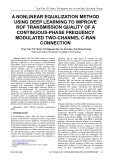
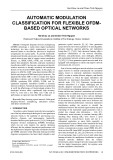

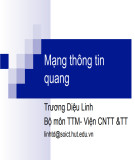


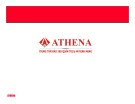
![Bài giảng Cáp mạng, vật tải truyền - GV. Lê Bá Thi [Chuẩn SEO]](https://cdn.tailieu.vn/images/document/thumbnail/2016/20160409/o0tchya0o/135x160/4531460212639.jpg)
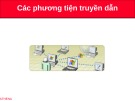



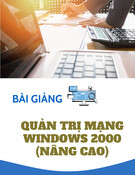
![Câu hỏi trắc nghiệm Mạng máy tính: Tổng hợp [mới nhất]](https://cdn.tailieu.vn/images/document/thumbnail/2025/20251001/kimphuong1001/135x160/15231759305303.jpg)
![Câu hỏi ôn tập An toàn mạng môn học: Tổng hợp [mới nhất]](https://cdn.tailieu.vn/images/document/thumbnail/2025/20250919/kimphuong1001/135x160/30511758269273.jpg)






![Giáo trình Công nghệ mạng không dây (Nghề Quản trị mạng máy tính, Trình độ Cao đẳng) - Trường Cao đẳng Thủ Thiêm [Mới nhất]](https://cdn.tailieu.vn/images/document/thumbnail/2025/20250916/kimphuong1001/135x160/13561758013095.jpg)



